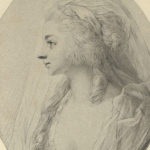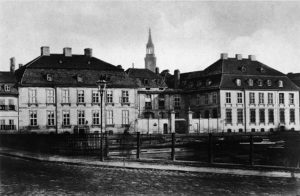By Anne Schuster Hunter
In Sara and Her Sisters Tempesta di Mare salutes three of baroque music’s great ladies, “really interesting, really powerful women,” Tempesta co-artistic director Gwyn Roberts says. “When I first found out about them I was literally up until four in the morning digging out journal articles. I just couldn’t stop reading.” Given the limits on women’s lives in the baroque world, it’s not every day that baroque music people find founding foremothers. And yet, there are the Itzigs.
In an unprecedented move, in old regime Berlin of the 1780s, Sara, Bella, and Fanny Itzig, along with a dozen-and-a-half other young women, opened their homes up as art and literary salons. They welcomed musicians, thinkers, writers and artists to come together and get to know each other. This was major for two big reasons. First, Berlin up to that point was a stodgy city where people barely mixed and women certainly didn’t lead. Second, the Berlin salonières were Jewish, in a city that barely tolerated Jews.
“They didn’t necessarily crack the glass ceiling. But they found a workaround and the history of music is forever changed because of it.”
The Itzigs’ story resonates now on so many counts that it’s almost hard to keep track. We can well appreciate, for instance, an early and dramatic example of cultural interchange and understanding in a divided place.
As well, the salonières are fascinating examples of early modern women who used their status as double outsiders to defy boundaries of class, religion, and gender expectations in German society.

Sara Itzig Levy
They turned the negatives of their lives into positives. As Jews, they weren’t allowed into mainstream high society, so they made a new society in their salons. As women, they weren’t allowed formal education, so they unapologetically marched to their own drummers and encouraged others to do so, too. Salon participants wrote or spoke their minds with eloquence and eagerness. Salonière Rahel Varnhagen, for instance, wrote over 10,000 unfettered letters which remain an important body of epistolary literature and early examples of German romanticism.
But one reason they have a special place in the heart of early music is that the Itzigs revived the work and reputation of J.S. Bach, at that point almost completely forgotten. “Without the Itzigs, we would not have a 19th-century Bach revival,” Roberts says. “Without the Itzigs, we’d be just discovering him today, he’d be as obscure to us now as Fasch, Graupner or Janitsch.”
Introduced to the Itzigs by Wilhelm Friedemann and Carl Philipp Emanuel Bach, Bach’s sons in Berlin, the music of J.S. Bach was an Itzig family passion. Sara—a very fine harpsichordist—performed and programmed works by Bach and by his sons and their circle. Bella collected Bach manuscripts, buying them on the open market and saving them when they would otherwise have been scattered.
When Felix Mendelssohn mounted his performance of Bach’s St. Matthew Passion at the Berlin Singakademie in 1829, an epochal moment and origin myth of the Early Music Revival, he was using a score that had been given to him by Bella Itzig—his little old Jewish grandmother.

Palais Itzig
And when Fannie Itzig moved to Vienna and opened up a Berlin-style salon, she introduced Mozart and Haydn to the music of Bach, which had a long ripple effect for both. “That’s why Beethoven’s last four quartets sound exactly like baroque counterpoint. That would not have happened if it weren’t for the sisters,” says Roberts.
The Berlin salons offer an example of history that’s only now making its way into narratives.
Camouflaged as “women’s work,” the salons provided women with an opportunity to shape tastes. They didn’t necessarily crack the glass ceiling. But they found a workaround and the history of music is forever changed because of it.
The tastemakers, preservers, cheerleaders and conduits, implementers and enablers (in a good way!) are the unsung heroes of cultural history. “To my mind, the Itzigs are no less important than the people who wrote down the notes,” Roberts says.
It’s time they get the recognition they’re due. With Sara and Her Sisters, Tempesta is pleased to provide it.
To learn more about the Itzig sisters, the Berlin salons, and their lasting cultural impact, please attend Anne Schuster Hunter’s pre-concert talks, offered one hour prior to each performance of Sara and Her Sisters.
Images:
Anton Graff, Portrait of Sara Levy. Wikimedia commons.
Daniel Itzig’s mansion, Berlin, on the corner Burgstraße and Neue Friedrichstraße. en.wikipedia.org.
For further reading, don’t miss Lauren Belfer’s And After the Fire, a 2016 novel about Sara Levy, her descendants, and present-day researchers who discover a startling new Bach manuscript. A New York Times interview with Belfer and her husband (musicologist and long-time Tempesta friend Michael Marissen) regarding the novel, 18th-century attitudes toward Judaism and what it’s like to write fake Bach is here.
